The main category of Fitness News.
You can use the search box below to find what you need.
[wd_asp id=1]
The main category of Fitness News.
You can use the search box below to find what you need.
[wd_asp id=1]
Elisa Tartler is a German archery competitor, competing with the recurve bow. She won a bronze medal at the 2024 European Outdoor Archery Championships in the team event. She also won a bronze medal at the 2022 World Games. She lives in Oberthulba, Germany and her coach is Oliver Haidn.
Women Fitness President Ms. Namita Nayyar catches up with Elisa Tartler an exceptionally talented German Archer, winner of bronze medal at the 2024 European Outdoor Archery Championships; here she talks about her fitness routine, her diet, and her success story.
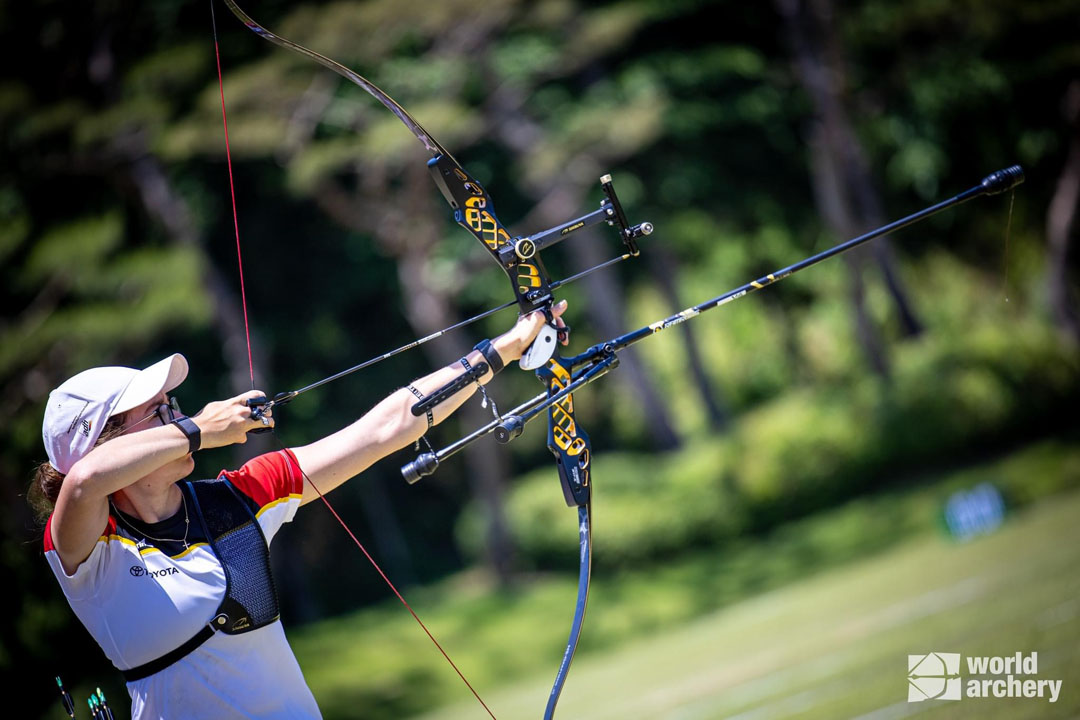
You live in Oberthulba, Germany. You started practicing archery in 2008. Later in the sports of archery you propelled your career to the height where you have been at the top of the world as an archery player. Tell us more about your professional journey of exceptional hard work, tenacity, and endurance?
Actually I am living in Berlin. I was born in Hammelburg and I grew up in a small town called Hetzlos. I started archery around 2008 and the big step into the national team was in 2015/2016. In 2015 I had my first ever World Championships. Since then I am part of team Germany. When I finished high school in 2017 I moved to Berlin as I started a job at the federal police sports group.
So I am a studied police woman but also a professional athlete, which allows me to focus all my day on training and competition. That’s really important because archery is a very time intensive sport. We shoot around 6-8 hours a day and do 1-2 hours of athletic training and additionally some mental training.
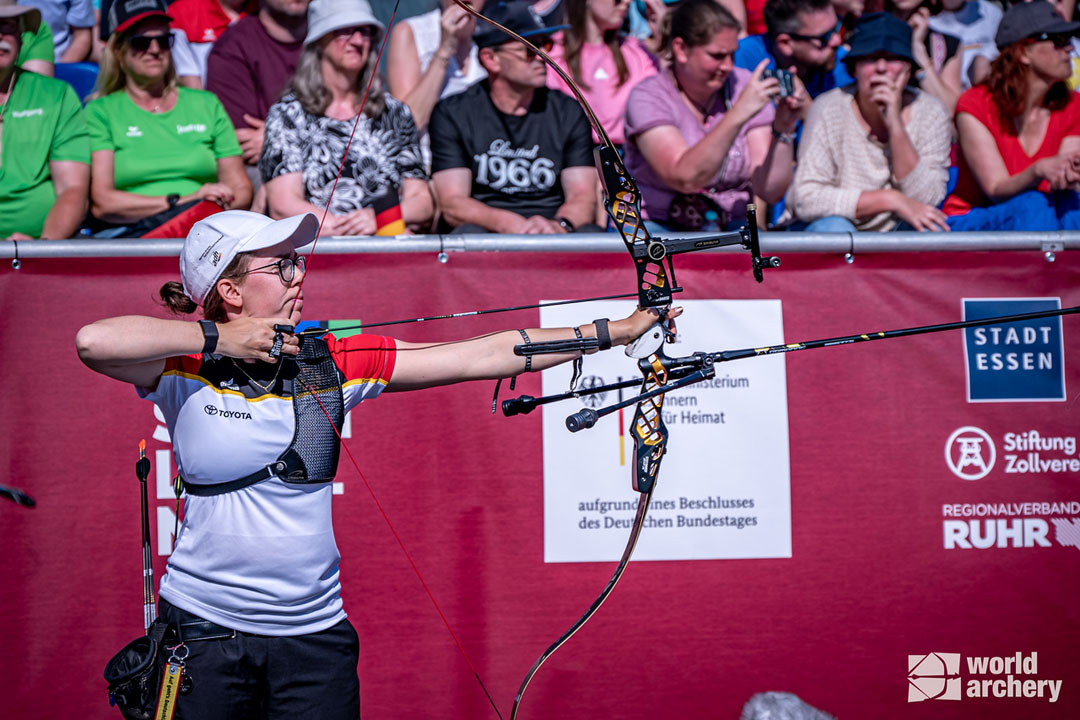
It is a dream for an Archer to participate in Archery World Games. You won a Bronze medal in the women’s individual recurve archery competition at the 2022 World Games took place from 10 to 12 July 2022 at the Avondale Park Historic District in Birmingham, United States. Tell us more about this spectacular achievement of yours?
My biggest dream is going to the Olympics in archery. Archery has the advantage that one discipline (70m target) is Olympic and another discipline (field archery) is at the world games. I am in both national teams and I participate in both. I haven’t been to the Olympics yet but 2022 was really special.
It was my biggest achievement at that point and kind of a relief. After not qualifying for the Olympic Games in 2021 I struggled with myself and winning an individual medal at such a big event was like everything finally paid off.
Full Interview is Continued on Next Page
This interview is exclusive and taken by Namita Nayyar President of womenfitness.net and should not be reproduced, copied, or hosted in part or full anywhere without express permission.
All Written Content Copyright © 2025 Women Fitness
Disclaimer
The Content is not intended to be a substitute for professional medical advice, diagnosis, or treatment. Always seek the advice of your physician or other qualified health provider with any questions you may have regarding a medical condition.
As told to Jacquelyne Froeber
May is Stroke Awareness Month.
“Why is my face numb?”
As I stared at myself in the mirror, everything looked fine to me. But the left side of my face definitely felt numb. Then I remembered that the tip of my tongue felt numb the day before.
Alarm bells started going off in my head. Was there something wrong with me?
I knew I was juggling a lot as a first-time mom, but I’d been feeling great up until that point. I’d had a speedy recovery after my C-section, and I was excited for my second day back at work. I felt like I had my life figured out.
So, I convinced myself that the numbness was no big deal. I’d probably slept hard on my left side near the baby monitor. And I probably burned my tongue on one of the many cups of coffee I’d been drinking to feel less tired.
Days went by but the numbness stayed, and the fatigue got worse. I ran into a friend who’s a physician assistant and told him how I was feeling. “Do you think it’s Bell’s palsy?” I asked.
“Maybe … but get it checked out,” he said.
I frowned. “What else could it be? I didn’t have a strokeor anything.” That was the only thing I could think of that was associated with numbness.
He agreed that I didn’t look like I had a stroke, but thought I should still see my primary care doctor. Luckily, I was able to get in to see her that day. She said I could have Bell’s palsy, but I needed to go to emergency care to be sure.
I tried to reason with her. I had work, a newborn at my neighbor’s house, and my husband was out of town — did I really need to go to the ER?
She said yes.
Two imaging tests later, the ER doctor said he thought I’d had a stroke, but they needed more testing to be sure.
I was stunned.
I’d joked about it before, but a stroke just didn’t seem possible. My face wasn’t drooping, and I didn’t have slurred speech. I was a healthy, active, 36-year-old mom who just had a wonderfully boring, uncomplicated birth. How was this happening to me?
I was taken to the neuro unit of the hospital where a nurse asked if I needed a breast pump. I noted there were a lot of pumps on the shelf behind her. “You wouldn’t believe how many new moms we get in here,” she said.
Jess holding her son, Stanley, in the hospital after her stroke in 2019.
I thought that was odd but later learned that your body goes into a hypercoagulable state after giving birth, which means your blood is more likely to clot and you’re at an increased risk for stroke.
This blew my mind. I’d been worried about 1,000 different things after having my son, but no one mentioned the increased possibility of a stroke.
The next day the tests confirmed that I did, in fact, have a stroke in my brain stem. My hypercoagulable state could’ve caused it, but no one knew for sure.
My doctor said I’d probably be fine. He prescribed me some medication and I went home. No one seemed to think it was that big of a deal, so I figured the worst was behind me.
Three days later, I woke up in bed staring at two ceiling fans. We only have one. For about 30 minutes, I tried to focus my eyes to make one fan, but I just couldn’t do it. I stumbled my way down the stairs and told my husband we needed to go back to the ER.
After more tests, the good news was that I wasn’t showing evidence of any new strokes. The bad news: No one knew what was causing my double vision. I was prescribed another medication and went back home disoriented and scared.
Unfortunately, the medication didn’t help. As disturbing as the double vision was, the fatigue was even worse. I felt like I was being weighed down by a thick fog that never lifted. The tiredness had become my new normal, so I did my best to push through the fatigue and stay as active as possible. I knew taking care of my physical health could only help in the long run.
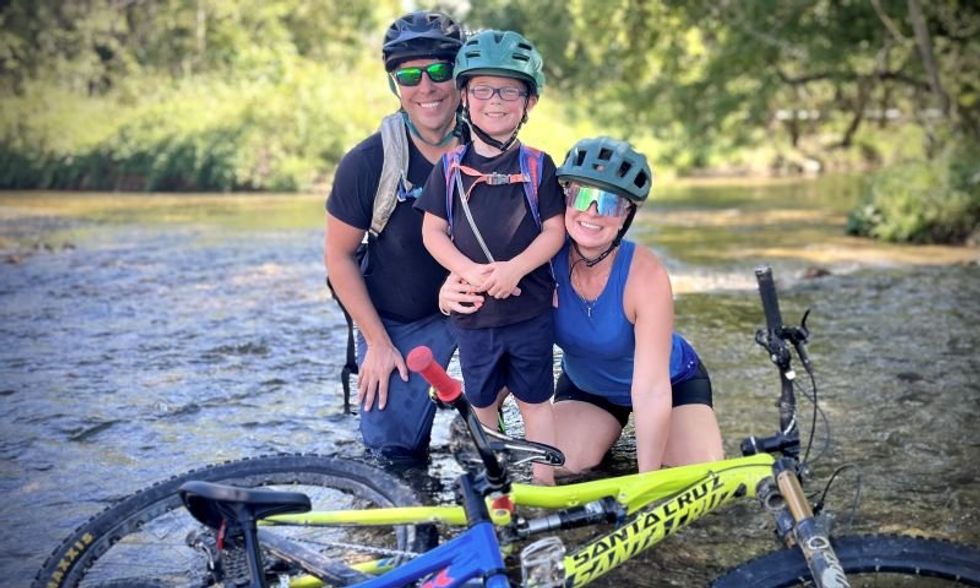 Jess with her husband and son, Stanley.
Jess with her husband and son, Stanley.
After two months, I did start to feel better. I had more energy and my vision was almost back to normal. But the relief was short-lived. I started having episodes where I’d lose command of my lips or tongue or my left arm or leg. The loss of motor skill only lasted about 30 seconds — but each time it felt like an eternity. I never knew when an episode would happen, but they were so frequent that I got good at hiding them.
I knew the whole situation was bizarre. Typically, people who’ve had a stroke show progress over time — I had a whole new set of symptoms. And no one could tell me what was going on.
Finally, I did find a doctor who said I was having episodes because my brain wasn’t getting enough blood. He said if we could slow or prevent the blood from clotting, the episodes would stop after about six months.
For the next half of the year, I took a new medication and tried to be patient with myself. It wasn’t easy. Every morning I woke up scared that I’d see two ceiling fans. And every time I had an episode, I feared I wouldn’t come out of it. Then, around the six-month mark, the episodes stopped. And they didn’t come back.
Over the years, I’ve been surprised by the amount of people who either know someone who’s had a postpartum stroke or had one themselves. I wish I’d known about the increased risk — maybe I wouldn’t have shrugged off the fatigue and numbness for as long as I did.
After my episodes stopped, I was good for a long time. But in 2021, I started experiencing trigeminal neuralgia, searing pain on the left side of my face — similar to where I had the numbness with the stroke. In the beginning, the pain would come and go, but as of today, it’s been more than a year of constant, unrelenting pain.
I think the pain is somehow connected to the stroke, but the doctors aren’t sure why it’s happening or how to treat the pain. It’s been a frustrating and time-consuming process, and some days the pain is so overwhelming I feel hopeless. But I know I have to keep pushing to find the help I need. Just because I haven’t found it yet — doesn’t mean it’s not out there.
Have your own Real Women, Real Stories you want to share? Let us know.
Our Real Women, Real Stories are the authentic experiences of real-life women. The views, opinions and experiences shared in these stories are not endorsed by HealthyWomen and do not necessarily reflect the official policy or position of HealthyWomen.
From Your Site Articles
Related Articles Around the Web
Pregnancy is often portrayed as a time of glowing joy, excitement, and anticipation. But for many moms-to-be, it also brings emotional challenges, anxiety, and silent struggles that often go unspoken. As we mark World Maternal Mental Health Day on May 7, it’s time to shine a light on an essential but often overlooked part of pregnancy: perinatal mental health.
Perinatal mental health refers to a woman’s emotional and psychological well-being during pregnancy and the first year after giving birth.
It includes a range of mental health conditions, such as:
These conditions are not rare. 1 in 5 women worldwide experience mental health problems during the perinatal period—yet many don’t receive the care they need.
Keep an eye out for signs like:
On World Maternal Mental Health Day, let’s remind every expecting mother: Your mental health matters. Your voice matters. You matter.
Disclaimer
The Content is not intended to be a substitute for professional medical advice, diagnosis, or treatment. Always seek the advice of your physician or other qualified health provider with any questions you may have regarding a medical condition.
En Estados Unidos, el cáncer endometrial es el más común de los cánceres que afectan los órganos reproductivos de las mujeres y de personas con asignación femenina cuando nacieron. Se diagnostican aproximadamente 66,000 casos cada año, y las tasas están aumentando.
No hay una prueba o examinación única para detectar el cáncer endometrial. Así que proveedores de atención médica (HCP, por sus siglas en inglés) usan muchos tipos diferentes de pruebas para hacer el diagnóstico.
Conocer el cáncer endometrial y cómo se diagnóstica podría ser útil para que sepas qué esperar.
El término cáncer endometrial se usa para cualquier cáncer que se origina en la mucosa de la parte superior del útero, también conocida como la cavidad uterina. Ocurre cuando un desencadenante que todavía no se identifica hace que células saludables de la mucosa (endometrio) muten o se conviertan en células cancerosas.
Lee: Información resumida: Lo que debes saber del cáncer endometrial >>
Sangrado anormal es el síntoma principal del cáncer endometrial. Eso incluye:
The Menopause Society señala que muchas mujeres posmenopáusicas con cáncer endometrial no reciben diagnósticos porque no saben que el sangrado, incluso si ocurre una sola vez, es una señal de alerta importante.
“Para mujeres posmenopáusicas, una secreción, sangrado o manchado vaginal no implica automáticamente que tengan cáncer, pero es importante hacer pruebas”, dijo Nita Lee, M.D., profesora adjunta de obstetricia y ginecología de la Universidad de Chicago.
Pero los proveedores médicos no siempre dicen a sus pacientes que se fijen si hay sangrado después de la menopausia. En una encuesta realizada por The Menopause Society, menos de la mitad de las encuestadas dijeron que sus doctores proporcionaron orientación relacionada con sangrado posmenopáusico y cáncer endometrial.
Incluso si mujeres posmenopáusicas tienen consultas con un proveedor médico acerca de sangrado irregular, es posible que no las examinen para detectar cáncer endometrial. “Frecuentemente, mujeres acudirán a sus doctores diciendo, ‘estoy teniendo manchado vaginal’, y doctores dirán, ‘eso es probablemente una infección urinaria (IU)'”, dijo Lee. Ella urge a mujeres que sienten que sus preocupaciones no se están tomando en cuenta seriamente que soliciten una examinación ginecológica o una referencia.
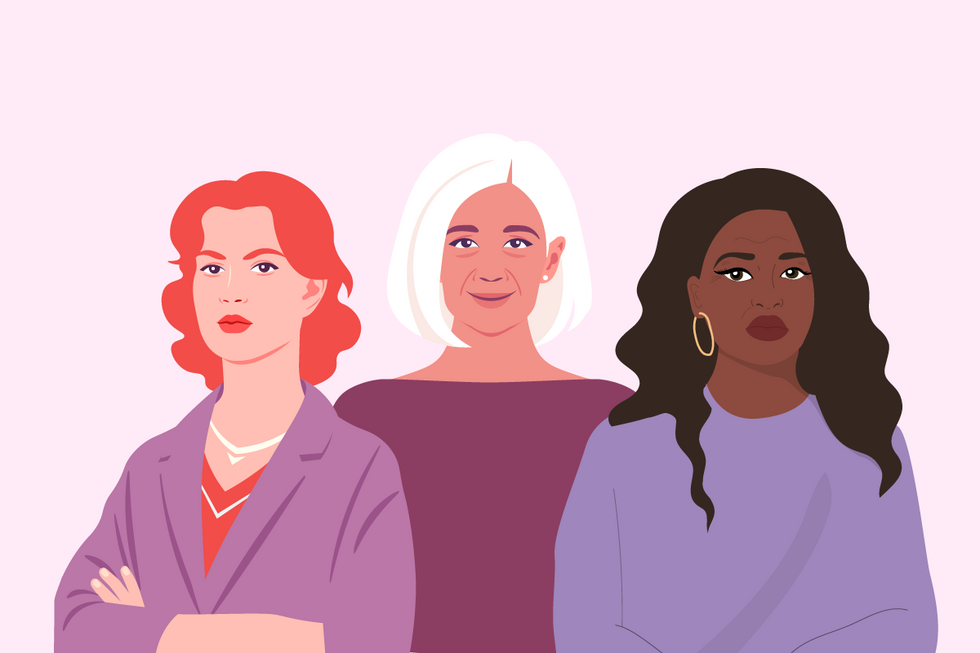
El cáncer endometrial es más frecuente en mujeres que han atravesado la menopausia. La edad promedio en la que se recibe el diagnóstico es a los 60 años.
Las mujeres de raza negra tienen más posibilidades de recibir ese diagnóstico en etapas más avanzadas, y de morir de cáncer endometrial. Las posibles razones para esta diferencia incluyen una mayor posibilidad de que las diagnostiquen con un tipo más infrecuente y agresivo de cáncer endometrial, su genética y el hecho de que las mujeres de raza negra con cáncer endometrial tienen menos posibilidades de recibir cuidados apropiados que mujeres de raza blanca. Expertos trabajan para obtener más información y concientizar sobre esta desigualdad.
Lee:¿Por qué las mujeres de raza negra son más propensas a morir de cáncer endometrial? >>
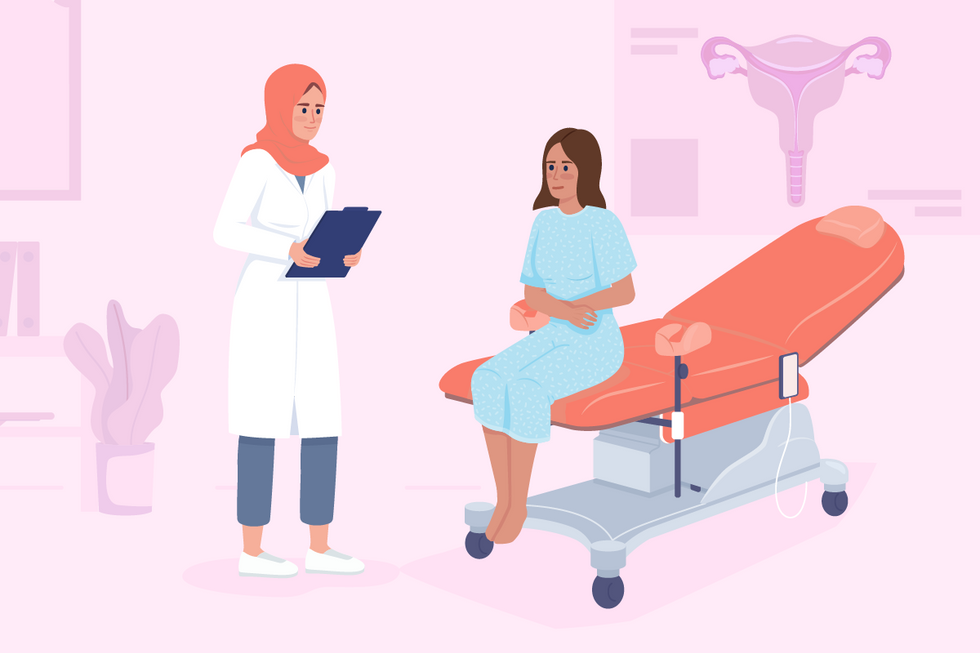
El proceso para diagnosticar el cáncer endometrial empieza con una conversación entre la paciente y su proveedor de atención médica. Es importante que compartas tus antecedentes personales y familiares para que tu proveedor médico pueda comprender de mejor forma cualquier factor de riesgo que pueda hacer que seas más vulnerable al cáncer endometrial.
Luego, tu proveedor de atención médica realizará una examinación física. Lee dice que una examinación pélvica es importante porque permite a tu proveedor de atención médica revisar cosas tales como el tamaño de tu útero y si el cáncer se ha propagado al cuello uterino o a la vagina.
Tu proveedor de atención médica también registrará antecedentes médicos detallados para conocer posibles factores de riesgo, incluyendo:
Lo que ocurre después de eso depende de tu situación única, pero te harán al menos una de estas pruebas:
¿Una prueba que no detecta el cáncer endometrial? Un Papanicolaou, que solo se usa para detectar cambios celulares en el cuello uterino que podrían causar cáncer cervical.
“Mucha gente piensa equivocadamente que si tuviste un Papanicolaou con resultados normales, no tienes cáncer endometrial ni uterino”, dijo Lee. Agregó que muchas de sus pacientes se sorprenden cuando les diagnostican cáncer endometrial después de años de pruebas de Papanicolaou con resultados normales.
Pruebas para detectar la propagación del cáncer
Si tu proveedor médico piensa que el cáncer se encuentra en una etapa avanzada, deberá realizar más pruebas para ver si se ha propagado a otras partes de tu cuerpo. Estas incluyen:
Estas pruebas se realizarán (o no) dependiendo de si tu cáncer está en una etapa avanzada, y de otras circunstancias específicas.
Una detección temprana es la clave
El cáncer endometrial es muy tratable si se detecta en forma temprana. La tasa relativa de supervivencia a 5 años es el 95% cuando el cáncer no se ha propagado, es decir cuando no se encuentra fuera del útero.
Si has tenido síntomas de cáncer endometrial o simplemente deseas conocer tu riesgo, habla con tu proveedor de atención médica. Si te preocupa el costo, la Fundación para la prevención del cáncer proporciona asistencia con pruebas de cáncer gratuitas y baratas.
Este recurso educativo se preparó con el apoyo de Karyopharm.
From Your Site Articles
Related Articles Around the Web
Women Fitness President Ms. Namita Nayyar catches up with Mina Mendes an exceptionally talented Fitness enthusiast; here she talks about her fitness routine, her diet, and her success story. She is also our Women Fitness Magazine Europe Digital Edition May 2025 cover star. Namita Nayyar: Your followers often admire your disciplined approach to nutrition. Can […]
The post Power Mode ‘MINA MENDES’ Unplugged appeared first on Women Fitness.
It’s hard to escape ultraprocessed foods these days. A whopping 70% of our food supply is ultra-processed in the U.S. And unfortunately, quantity doesn’t necessarily mean quality when it comes to these food and drink options.
Many studies have linked ultraprocessed foods to an increased risk for serious health conditions such as obesity, Type 2 diabetes and cardiovascular disease — the number one cause of death for women in the U.S. And one recent study found that consuming ultraprocessed foods increased the risk for ovarian cancer by nearly 20%.
So, given the fact that ultraprocessed foods seem to have more red flags than your ex, why can’t we quit them? It has a lot to do with convenience and marketing. For many people, grabbing a frozen pizza is easier than preparing fresh foods. And popular brands, attractive packaging and advertising campaigns help sell ultraprocessed foods around the globe.
Ultraprocessed products are a bit of a Franken-food. Making them requires several stages of processing, which can include chemically modifying substances like sugar and oil and applying industrial techniques like high-pressure shaping. It’s common for ultraprocessed foods to include additives such as artificial flavors, colors and sweeteners to make the product look and taste good.
This is a long way of saying that ultraprocessed foods contain ingredients you wouldn’t find in most kitchens — unless your kitchen doubles as a lab (e.g., high-fructose corn syrup, hydrogenated oil, red dye 40, etc.).
Together, the ingredients and industrial manufacturing processes create products that are convenient (typically ready-to-eat or heat), have a long shelf life and attract the senses. But when compared to whole foods that aren’t processed or are minimally processed, ultraprocessed foods are associated with a whole list of health concerns.
The research behind ultraprocessed foods is complicated. Although it’s clear that diets rich in ultraprocessed foods can lead to increased health risks, research is still ongoing regarding a clear reason as to why ultraprocessed foods have a negative effect on health.
We do know that ultraprocessed foods tend to be higher in fat, added sugar and salt compared to unprocessed or minimally processed foods like fruit and vegetables. Ultraprocessed foods are also lower in vitamins and minerals and fiber — all things our bodies need from food.
The type of ultraprocessed foods we eat may have something to do with the increase in disease. One study found that people who consumed processed meats and sugar had an increased risk for cardiovascular conditions, but people who ate bread and yogurt, which are also ultraprocessed foods, had a lower risk.
Studies also show that ultraprocessed foods are associated with health conditions such as cancer, obesity and even premature death. One recent study found that women and people assigned female at birth (AFAB) who drank more than two servings of ultraprocessed sugary beverages a day had a 63% increased risk of early death, compared to women who had less than one ultraprocessed drink a month.
Ultraprocessed foods are designed to be pleasing to the palate, so you instinctively want to eat more (I see you nacho-cheese chips). Studies have found that ultraprocessed foods can lead to food addiction among people living with overweight and obesity.
Research also suggests that the industrial processes make ultraprocessed foods quicker and easier to digest than whole foods. This may cause your stomach to skip sending the “Hey, I’m full!” signal to your brain.
The additives in ultraprocessed foods can also have a negative impact on gut health and disrupt your gut microbiome. This can cause inflammation, lower levels of the good gut bacteria and throw off the gut-brain connection that contributes to good brain function.
Read: Gut Health and Brain Health. What’s the Connection? >>
Ultraprocessed foods can affect your mental health in different ways. The high amounts of sugar and carbohydrates in ultraprocessed foods can lead to spikes in blood sugar, which can affect brain cell reaction over time. This could potentially affect brain function and contribute to cognitive decline.
For women and people AFAB, ultraprocessed foods may be particularly dangerous regarding mental health. A 2023 study of 21,000 women ages 42 to 62 found that participants who ate at least nine servings of ultraprocessed foods a day were 50% more likely to develop depression than the women who ate a max of four servings per day.
If you’re headed down the grocery aisle and wondering if your favorite product is ultraprocessed, the first thing to do is check the label. If the item has a long list of ingredients — more than five — it’s probably an ultraprocessed food or drink. Or, as mentioned before, think about your kitchen. Would you find that ingredient in there? And any color additives are a big red flag.
By now you’re probably not ultra-surprised to learn there are many different types of ultraprocessed foods out there ranging from fizzy soft drinks to ready-to-eat items.
Examples of ultraprocessed foods can include:
It’s not realistic to go cold turkey and cut ultraprocessed foods completely out of your life. But there are steps you can take to reduce the amount of ultraprocessed foods you eat.
Ultraprocessed foods may be everywhere, but whole foods are always ultra-cool and better for your physical and mental health.
Related Articles Around the Web
Niranjana Parthasarathi, M.D., empezó a experimentar fatiga extrema y dolor de las articulaciones unos años después de su 20° cumpleaños.. Unos meses después, le diagnosticaron lupus. “Estudiaba medicina, así que sabía lo grave que esto podía ser”, dijo, recordando como una de sus compañeras había fallecido trágicamente debido a complicaciones de este trastorno autoinmunitario durante una pasantía.
Parthasarathi empezó a estudiar un posgrado y pudo tomar un poco de tiempo de descanso durante su residencia médica cuando tuvo un brote, término que se usa para períodos de tiempo durante los cuales el trastorno se vuelve más activo. Se convirtió en una internista muy respetada y trabajó a tiempo completo como profesora adjunta de medicina interna. Pero cuando tenía 50 años, experimentó un brote que causó una insuficiencia renal aguda grave y la dejó discapacitada.
“Desafortunadamente no he podido volver a trabajar a tiempo completo o incluso en forma continua a tiempo parcial”, dijo.
A pesar de este cambio devastador, Parthasarathi, ahora de 62 años, todavía considera que es afortunada, tuvo una red y acceso a atención para que le diagnostiquen rápidamente y sigue teniendo un seguro médico que cubre su atención médica continua, lo cual ha incluido quimioterapia, transfusiones sanguíneas e inmunosupresores. Para personas que no tienen acceso a ese tipo de recursos, los costos relacionados con lupus pueden ser devastadores.
“Si tienes que hospitalizarte, ir a una sala de emergencias, someterte a todas las pruebas que necesitas que se hagan cuando tienes lupus, porque se supone que se debe analizar tu sangre y tu orina cada tres a seis meses, estos costos pueden convertirse en montos importantes con el tiempo”, dijo Jessica Williams, M.D., MPH, profesora adjunta de medicina de la división de reumatología de la facultad de medicina de la Universidad Emory en Atlanta, Georgia.
La carga financiera de manejar el lupus puede ser muy diferente en función de cuán grave es la enfermedad, según un estudio publicado en The Journal of Rheumatology. Investigadores descubrieron que pacientes con lupus graves tuvieron costos médicos anuales de $52,951, mientras que casos leves costaron un promedio de $21,052. Estos gastos también incluyen costos indirectos, tales como salarios no percibidos. Un estudio de 2021 publicado en Lupus Science & Medicine tuvo hallazgos similares, con costos de $68,260 para casos graves y $13,415 para casos leves.
El estudio también reveló que incluso antes del diagnóstico, pacientes que eventualmente desarrollan lupus graves ya tienen costos médicos significativamente mayores.
“El lupus es un trastorno autoinmunitario que puede afectar cualquier parte del cuerpo, así que los pacientes pueden tener síntomas relacionados con muchos aparatos y sistemas diferentes”, explicó Williams. En promedio, recibir un diagnóstico correcto toma cinco o seis años para la mayoría de pacientes, parcialmente porque los síntomas pueden aparecer y desaparecer en periodos de brotes y remisiones y también porque los síntomas pueden confundirse con los de otros trastornos crónicos. Este retraso puede causar gastos médicos adicionales mientras que los pacientes deben tener consultas con varios proveedores de atención médica para encontrar respuestas.
La dificultad financiera es particularmente dura para las mujeres, quienes tienen 9 de cada 10 casos de lupus. Muchas mujeres con lupus están en su edad reproductiva, una época en la cual brotes de la enfermedad pueden interferir con sus carreras y estabilidad financiera. Un estudio determinó que ser una mujer con lupus puede asociarse a resultados laborales desfavorables, lo cual incluye días en los que no se puede trabajar y renuncias laborales debido a razones médicas. Síntomas tales como fatiga extrema, dolor y dificultad para concentrarse pueden afectar la capacidad de los pacientes para hacer bien sus trabajos, y brotes más graves pueden hacer que se reduzcan sus horas laborales, que asuman cargos menos demandantes o incluso que dejen de trabajar por completo.
“Las mujeres con lupus frecuentemente sufren una devastación financiera y puesto que nuestro sistema de salud está vinculado al empleo, eso puede resultar empobrecedor”, dijo Parthasarathi, que escribió el libro “Lupus: In the Jaws of the Wolf [Lupus: en las fauces del lobo]” que es una guía personal para vivir con la enfermedad y para conocer el sistema de salud.
El lupus también empeora las desigualdades financieras de las mujeres de color. “Sabemos que el lupus es más frecuente para pacientes de minorías raciales y étnicas de todo origen”, dijo Williams, quién fue la jefa de investigación de un estudio de 2023 que se publicó en Rheumatology que analizó las disparidades demográficas de los desenlaces clínicos de pacientes con lupus.
Las mujeres de raza negra e hispanas, en particular, son más propensas a desarrollar lupus y a experimentar formas más graves de la enfermedad, incluyendo complicaciones tales como nefritis lúpica que puede causar insuficiencia renal y la necesidad de diálisis, un gasto potencialmente inmenso. Williams señala que estos grupos no solo que tienen un mayor riesgo de desarrollar lupus, sino que también son más propensos a tener peores desenlaces clínicos debido a factores tales como un acceso limitado a la atención médica, a no tener una cobertura adecuada en lo que se refiere al seguro médico y a exposiciones medioambientales.
Estos grupos también son más propensos a tener seguros públicos y el estudio de Williams reveló que pacientes afiliados a Medicare o Medicaid tienen mayores tasas de reingreso a hospitales en los siguientes 30 días después de la hospitalización y hospitalizaciones prevenibles de lupus en comparación con pacientes que tienen seguros privados. Además, menores niveles de ingresos se asocian a una mayor actividad de la enfermedad, a lesiones de órganos, a depresión, a discapacidad laboral y a la mortalidad. Pacientes que viven con pobreza frecuentemente reportan solo poder controlar su lupus durante brotes de la enfermedad y no poder cuidarse mientras tienen remisiones debido a otras necesidades tales como alimentación y vivienda.
“Muchos de los fabricantes de medicamentos de lupus tienen programas de asistencia a pacientes”, dijo Williams. Recomendó preguntar a instituciones médicas acerca de programas de asistencia financiera y comunicarse con oficinas locales de Lupus Foundation of America, las cuales podrían proporcionar apoyo en lo que se refiere a vivienda y alimentación.
En el libro de Parthasarathi, cuyos ingresos provenientes de sus ventas se donan a Lupus Foundation of America y a Lupus Research Alliance, se enfatiza la importancia de medidas relacionadas con el estilo de vida que pueden ser útiles para controlar la enfermedad, particularmente para personas que no tienen acceso a todos los tratamientos disponibles. Algunos consejos incluyen comer más alimentos de origen vegetal, descansar más, reducir el estrés y caminar 30 minutos al día, si eso es posible.
Para mujeres que podrían tener dificultades para recibir un diagnóstico, Williams y Parthasarathi las invitan a que tomen medidas especiales para obtenerlo. Williams sugiere tomar fotos y vídeos y registrar las fechas de los síntomas en un diario durante brotes para aprovechar más las consultas médicas durante las remisiones.
Parthasarathi dijo, “me gustaría que las personas que recibieron diagnósticos de lupus se sientan empoderadas para asumir el control de sus vidas. No solo que hay medidas relacionadas con el estilo de vida que pueden tomar para mantenerse más saludables, sino que también descubrirán que son más resilientes de lo que piensan”.
Este recurso educativo se preparó con el apoyo de Novartis.
From Your Site Articles
Related Articles Around the Web
Most teenagers wrestle with what they want to do when they grow up — but not Jennie Joseph. “All my teachers and advisors were saying I should be a secretary or a teacher — and I said I’m going to be a midwife,” she recalled. “I barely knew what it was, but I knew it was exactly what I wanted to do.”
Call it midwife intuition. Joseph, who is British and trained in the United Kingdom, is now a world-renowned certified professional midwife (CPM) and known for her patient-centered care. Called “The JJ Way,” her approach has been effective in reducing disparities and improving birth outcomes for thousands of women.
Since moving to the United States in 1989, Joseph has been a pioneer in growing the profession and addressing rising maternal mortality rates, particularly among Black women. As the founder and president of the nonprofit Commonsense Childbirth Inc., Joseph opened the first nationally accredited, private midwifery school owned by a Black woman. She also helped develop the National Perinatal Task Force that helps women find Perinatal Safe Spots in areas in the U.S. where it’s not safe to be pregnant or parenting children.
In 2022, Joseph was named one of Time magazine’s Women of the Year for her work and advocacy in maternal health. And most recently, Joseph collaborated with other health experts for the 2025 World Cup Health Rankings, which evaluates maternal health outcomes in soccer-playing nations around the globe. The U.S. was 44 on the list — the lowest ranked developed nation. Joseph said midwifery can be the life-saving help we need.
This interview has been lightly edited for clarity and length.
Midwifery is a medical practice that also incorporates spiritual, emotional and family care during the maternity time. We take care of women during this normal life process, and if it becomes abnormal or high risk, that’s when an obstetrician steps in.
Historically, women have always helped other women during birth, so the profession of midwifery is one of the oldest professions if you think about it.
The difference for the American concept of midwifery, is that back in the day, everyone used a midwife, and everyone was born at home. Around the midcentury, hospitals and physicians decided to move into the profession, seeing it as a commodity — as in there is money to be made during childbearing. Obstetricians in other countries around the world typically are on standby for high risk cases but in the United states the widespread use of obstetricians moved midwives aside and nearly eradicated midwifery — particularly midwives in certain communities, such as Black midwives serving the southern states, Indigenous midwives and immigrant midwives.
The new idea was that you should be in this hospital situation, that everyone should be with high-level providers. So we switched from having 90% of births happening in the home environment for centuries to the institutional birthing that is now happening in the United States, always monitored by high-risk specialists. We changed childbirth into a non-normal event, a dangerous life-and-death, living-on-the-edge kind of situation that can only be solved by getting yourself into the hands of highly skilled specialists.
OB-GYN medicine that incorporates midwifery may have midwives on staff — nurse practitioners who are practicing in the midwifery model of care. And those people who do the pre- and postnatal part of care. They follow you to the hospital environment and support you in the hospital.
The other way that it’s happening is in the community space where there are midwives — like myself — who have their own freestanding clinics and birthing centers in the community where they offer low risk and healthy women the opportunity to have a natural birth. This is where a lot of the water births — for example — are happening in these types of settings and communities.
And of course there’s also quite a large contingent of folk who choose to have a natural birth at home. And by natural birth, we’re saying non-complicated, no medication typically, and you learn to manage your pain in other ways. This may be movement, water, different herbal teas, aromatherapy — all these other natural modalities to help you through the process of birth.
It’s becoming more popular to integrate a midwife like myself who has a freestanding practice. I’ve made it my business to work with a hospital should something happen during the course of the midwifery care. For example, during prenatal care if someone gets high blood pressure, they are no longer for midwifery care because they’re at high risk. So, we transfer the care to the obstetrician to manage the high-risk pregnancy.
Sometimes this happens during labor — you can’t really predict labor. So, if something happens, we transfer from the birthing center or home to the hospital to finish the birth.
When midwifery is integrated and part of a collaborative of providers, we see the safest modality you can possibly choose. You have the best of both worlds: You have that support and the medical care that midwives can offer as long as you stay low risk, and you also have the opportunity for medical care or emergency care if you become high risk.
When you integrate that type of comprehensive model, you have a model that mirrors everyone else’s model around the rest of the world because midwifery is a standard profession everywhere else.
In America, we’re at the point now where we’re at a bit of a dilemma because midwifery is not autonomous here. The general public are not even really aware of what midwifery is, and many people think midwives are doulas — but they’re not.
The difference between the midwife and doula is that the midwife provides both sides of the equation. The same support that a doula would provide, which is educational support, emotional support, listening, planning and helping you determine what you would like and what you wouldn’t like. Doulas are physically with you from the start to the finish of your labor and delivery, and they provide continuous non-medical care according to your own wishes.
They can also help you in the perinatal stage with nutritional information and during postpartum with the newborn and lactation.
Midwives provide non-medical, supportive work in the maternity world plus the medical aspects of maternity care. For example, they will check your blood pressure, check your urine, measure your tummy, see if your baby’s heart rate is normal, help you prepare for the birth. They will make sure you have everything for the event. And then during the event, they can continue to provide you with medical care and monitor you, manage your labor, help you deliver the baby and help with recovery.
So, the medical aspects of maternity are provided by the midwife, the emotional and support aspects are provided by the midwife or doula, and the high-risk aspects such as complications — high blood pressure, preeclampsia, prematurity, babies with abnormalities, mothers with postpartum mental health conditions — all of these require higher-level specialties and an obstetrician.
Yes. You can have both. You can also have a doula and an obstetrician — which is what a lot of people do. In the hospital, the doctors and nurses work with the doula, and the doula continues postpartum care.
It’s a partnership, and integration is the key. If all these providers could work in harmony, the result would be the improvement — or I would say almost the eradication — of horrendous disparities that we see not only racially but socially. Low-income women, women who are uninsured, women who are on Medicaid all have different outcomes — not based on their physiology but based on social construct that impacts how people treat them.
So, whether it’s race, class, immigration — whatever the status that has that person “othered” — we’ve seen a continual set of statistics that report that their care is different compared to everyone else. And these differences in care are where these disparities come from. That’s why we are so woefully behind every other developed country in the world. We are the most highly resourced country ever, and yet we have mothers and birthing people suffering structural harms and ways of being that literally impact their experience of childbearing to the point that it’s so detrimental that we are all suffering.
This again goes back centuries. Midwives have made sure to center mother and baby, center the family, and deliver the medical care. Midwives can address this issue in the United States by essentially just being themselves.
This is why scaling midwifery, integrating midwifery and growing that profession is key. We train midwives at my school to be community providers. We get more people access to midwifery as we grow the profession of midwives, and we support the midwives as we integrate the midwives. So, it’s a very deep impact on our outcome.
For example, our practice has been up for 27 years, and we have not had a premature percentage over 5% since we’ve been working in these clinics and birthing centers. When we first started this work, 1 in 5 Black women were having a premature baby. In our practice last year, we had four preemies and all survived and all were fine. The year before, we had one preemie — and that’s out of about 400 to 500 women every year.
Read: Can Living in the U.S. Increase Your Risk of Preterm Birth? >>
The midwifery model is protective. We make sure people feel seen and heard. That they can feel partnered in their care. And it doesn’t matter if you have the baby in your back bedroom or in the hospital — when you have that care from midwifery, you’re going to have a better outcome. We have very few cesarean births. We have very few complicated births.
Not to blame anyone — it’s just the system — but the way we do obstetric care in the United States is so cold and impersonal and so rushed that there’s no room for a calm approach. Panic and fear, intervention and legislation — I call it the industry fear — we have to learn how to navigate that industry in order to be able to survive it. And there’s something wrong with that. That doesn’t make sense. So, midwifery is one answer to that.
We currently have almost 400 perinatal experts listed on the National Perinatal Task Force. Those experts are groups of midwives, doulas, child experts, lactation educators — people who are operating in their community to be a place where you can get good information and good support.
If I was able to dream — if I could really just be wild with my hope — I would say that I wish every person had access to a midwife. They may not choose to use one, but at least they have access if they should choose it.
I wish everyone could have a sense of peace, a sense of joy, a sense of accomplishment for the experience of going through childbearing and bringing life. That they know they are supported. That they are loved. They know they are recognized for what they are doing and how they go forward. But we are way off of that goal.
Let’s hope, and let’s keep working. We have to work toward that. It doesn’t just happen.
This is where we know the power of advocacy — of really getting to our systems that have these perverse ways of being. Our hospital systems are overrun. They are understaffed, and the existing staff are at their wit’s end. They don’t want to cause additional harm, but they are stuck. So, we need policies where we can support community-based organizations to integrate with the hospitals to support them. As I mentioned earlier, our outcomes at my clinic are pretty stellar — no low birth weight, no premature births — we’ve never lost a mother. No one has ever died in the entire 27 years, and that’s because we work closely with our hospital.
We are bringing together the collaborations, bringing the stakeholders to the table, bringing the policies that allow us to get along as opposed to keeping these silos so far apart. It’s community organizing and advocacy education that helps solve the root cause of these disparities. It’s not that a mother had that bad outcome because she’s living with obesity. No! It’s because there’s not enough structure to give support to her.
People in the nonprofit and philanthropy world need to provide help to those who are still shut out and change the systems we already have in place. Those systems have to change. So that’s the work.
From Your Site Articles
Related Articles Around the Web
From a young girl with a passion for speed to a double Olympic gold medalist and one of the greatest try-scorers in rugby sevens history, Michaela Blyde’s journey is a testament to resilience, determination, and sheer talent. The New Zealand star has shattered records, won multiple world titles, and redefined excellence in the sport.
Women Fitness President Ms. Namita Nayyar catches up with Michaela Blyde, New Zealand professional rugby sevens player and double Olympic gold medalist.
She opens up about the heartbreak of missing the Rio Olympics, the mindset shifts that led her to back-to-back World Rugby Sevens Player of the Year titles, and what it takes to stay at the top of her game. Join us as we dive into the training, discipline, and determination that fuel her success on and off the field.
After graduating she studied for a Certificate in Animal Care at Otago Polytechnic in Dunedin. In 2014 she commenced a Bachelor of Sport and Exercise through correspondence at Massey University. Her younger brothers, Liam and Cole were academy rugby players with Taranaki, Liam went on to be selected for a development project for the men’s Sevens team before playing for the Taranaki Bulls in 2021.
Representing New Zealand Women’s rugby sevens
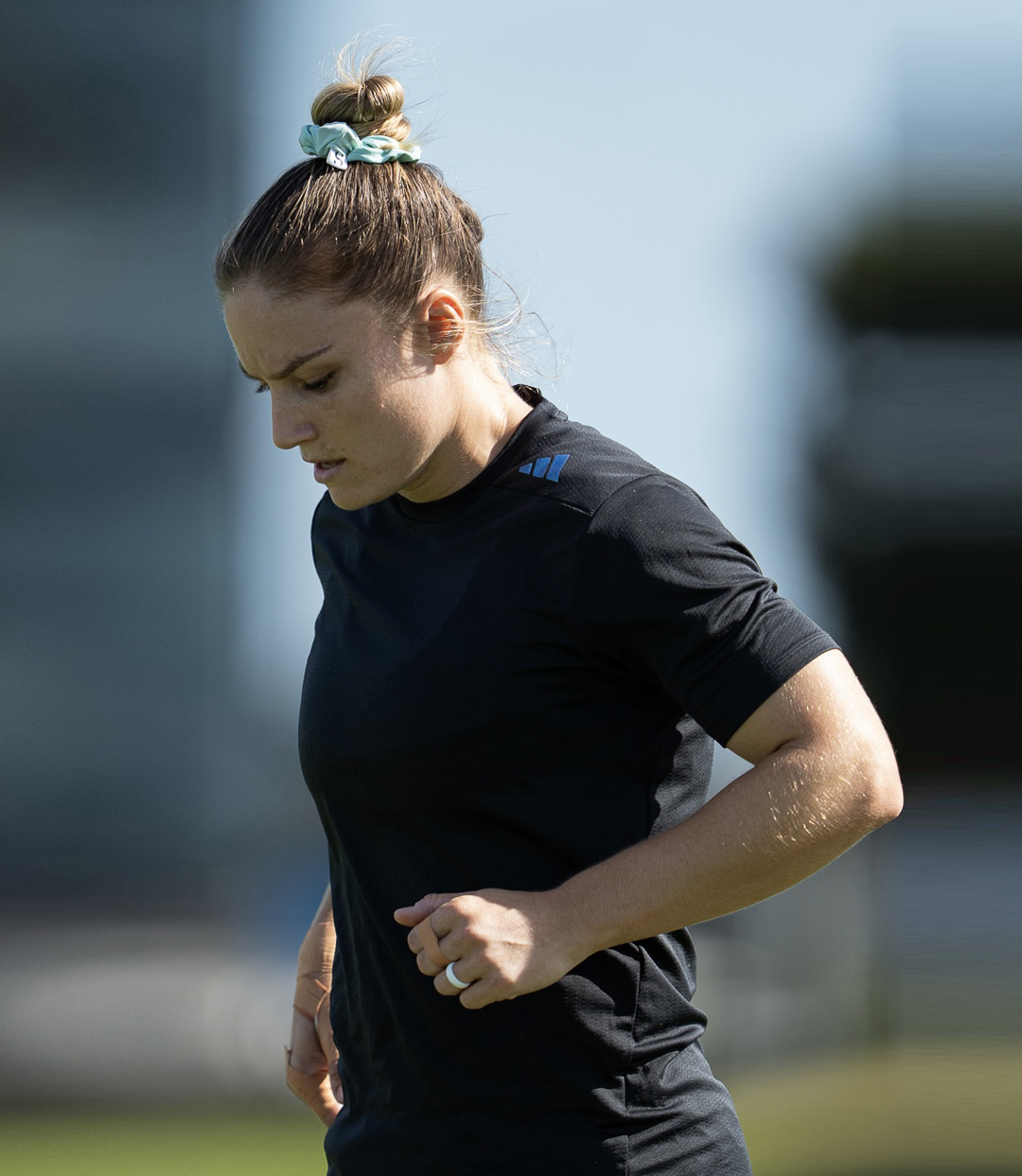
Discover the resilience, speed, and passion behind her historic wins in our exclusive interview. A champion’s mindset unveiled!
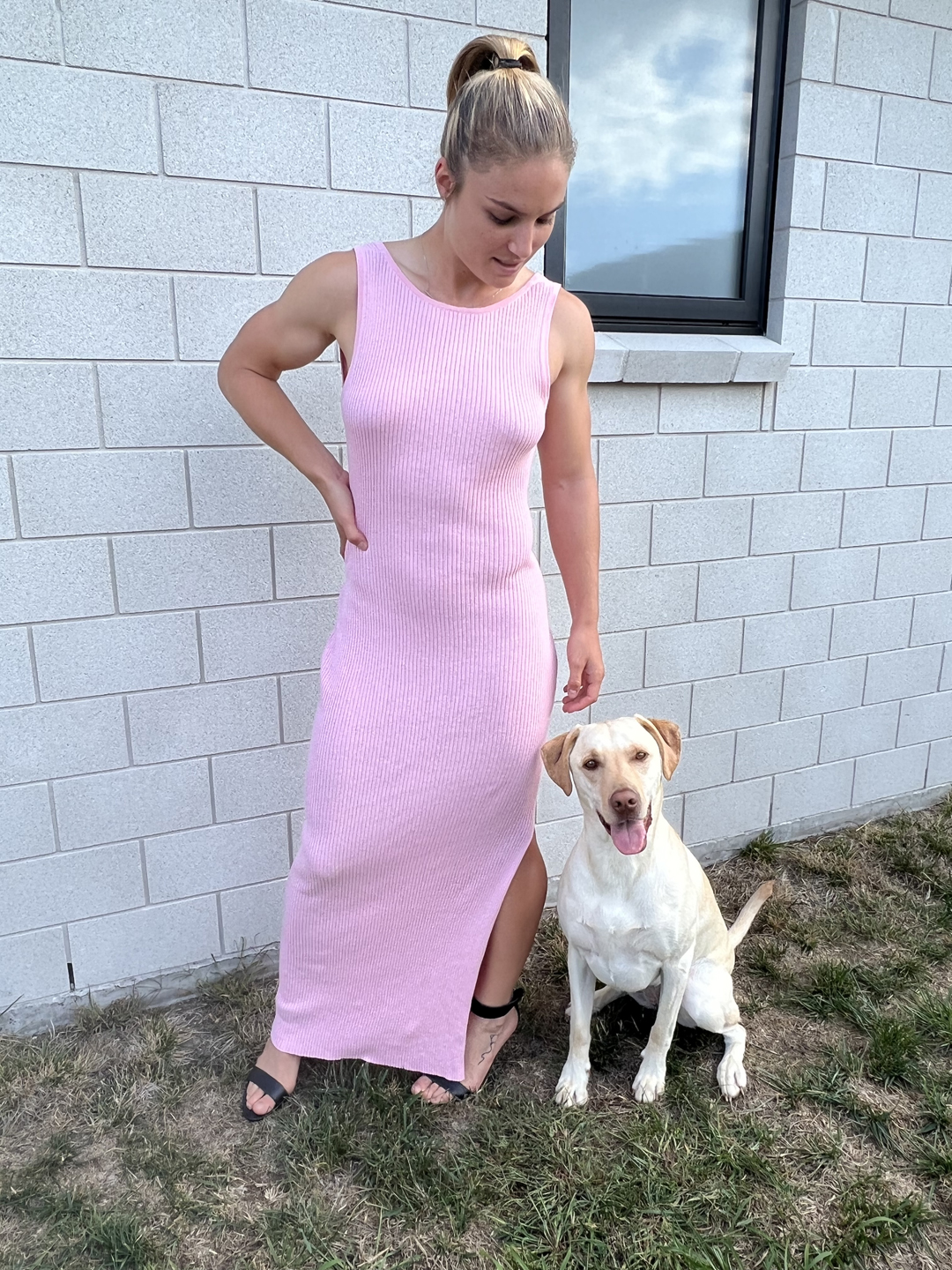
You were born in New Plymouth, New Zealand. You attended New Plymouth Girls High School. From 2009 to 2013 you competed in athletics in the 100 meters, 200 meters and long jump. You started playing rugby at the age of five years, and joined local rugby club, Clifton. Alongside representing New Zealand you played for your school in the 2013 Condor Sevens, which was the first time New Plymouth Girls High had fielded a team in this National Secondary Schools Rugby Sevens competition. You were named Player of the Tournament and were also selected for the tournament team. This later propelled your career to the height where you have been at the top of the world as a women rugby player. Tell us more about your professional journey of exceptional hard work, tenacity, and endurance?
When I was first named in the New Zealand Women’s 7s squad in 2012, I was still at school so I was juggling the balance of training plus school plus homework. It was tricky but with the support of my parents I was able to graduate high school and still receive a training contract. But my love for professional sport started when I was 5 years old. I had a dream of competing at the Olympic Games and win gold in the 100m and 200m, so I would vision myself doing just that every time I competed at athletics track events. I also loved the feeling of getting fitter, faster and stronger so I would train after school either with my siblings and Mum at home, or have team sports training after school when I was playing football.
My parents are dairy farmers in Taranaki which means no days off, so I was used to seeing hard work every day as my parents epitomized what it means to work hard to put food on the table. They always encouraged me and my brothers to do the extras to make sure we were ahead of everyone else.
It is a dream for a rugby player to play in the Olympics. At the 2020 Tokyo Olympic Games, You scored seven tries in five matches, including in the final, which New Zealand won, earning you a gold medal. Tell us more about this spectacular achievement of yours?
It was the moment my 20 year old (at the time) dream came true. All the hard work that I put in to win an Olympic Gold paid off so it was a very overwhelming feeling, I immediately thought about that 5 year old Michaela who had a big dream and didn’t let anyone tell her it wasn’t possible. I had my ups and downs, non-selections, injuries, but I kept my goals focused on the bigger picture and just simply never gave up. But I also wasn’t fully satisfied winning a gold medal in front of no one due to COVID restrictions so I was also very hungry to do the hard work all over again to try winning another one in Paris 2024. I also felt like I didn’t play my best rugby so I was also very determined to be better physically and mentally for Paris.
Full Interview is Continued on Next Page
This interview is exclusive and taken by Namita Nayyar President of womenfitness.net and should not be reproduced, copied, or hosted in part or full anywhere without express permission.
All Written Content Copyright © 2025 Women Fitness
Disclaimer
The Content is not intended to be a substitute for professional medical advice, diagnosis, or treatment. Always seek the advice of your physician or other qualified health provider with any questions you may have regarding a medical condition.